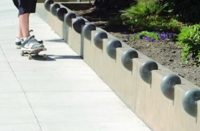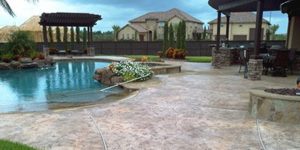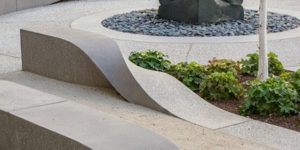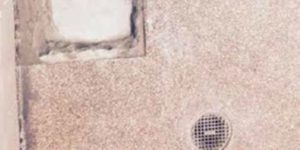
One of the most popular applications for architectural concrete is the pool deck. Decks have been constructed with concrete for as long as there have been modern swimming pools, and we all remember the hot, scratchy surfaces of our childhood. But new decorative finishing techniques make pool decks comfortable, durable, safe and — most noticeably — beautiful. “The pool deck is the largest thing that people will see in the context of pool and deck,” says Tom Ralston of Tom Ralston Concrete, Santa Cruz, Calif. “Done right it can be all the more enhancing; done poorly and it can make a nice feature turn to extreme ‘blah.'”

Much more than a patio
Pool decks may look like patios, but because they must perform differently there are some differences in how they are installed and finished. “Good quality concrete practices, slope, climate and safety should be the main factors considered when designing and installing a pool deck,” says Scott Thome, director of product services for L.M. Scofield Co.
Perhaps the most significant of these is slope, required for proper drainage. Typical patios “fall” 1/8 inch every foot to allow for water run-off and to prevent ponding. The recommended slope for pool decks is ¼ inch per foot. This accommodates the extra volume of water and keeps leaves and debris from washing into the pool. “Anytime you’re moving water to a designated point, length of run, amount of water and surface texture should all be considered,” Thome explains. “If designed correctly, water should move freely to the designated area no matter which textured pattern is chosen. Of course, less texture develops less friction, and water will move with less slope.”
Ralston agrees that greater slope will drain water more effectively, but says, “We feel ¼ inch is too much fall and when setting patio furniture it is a little more noticeable and not as comfortable. There is always a light bit of water here and there, and we let the clients know that. Ultimately, it is the client who will make the decision.”

Chris McMahon, president and CEO of Architectural Concrete Design in Levittown, Pa., warns contractors to pay attention to cut and fill situations. “A pool is level, and if a yard is pitched you have to cut into the bank on one side and fill the other side,” he says. “On the fill side you have to worry about the deck settling away from the pool.” A good pool builder will compact the soil properly when the pool is put in. If not, McMahon recommends installing piers: drilling down to virgin ground every four or five feet, filling the columns with concrete and pouring the slab on top of them so that the deck won’t settle.
Choice of color for a pool deck goes beyond mere aesthetics. Color affects how much heat the deck retains, so it is important for comfort too. “Dark colored pool decks are going to be hot,” McMahon says, “so you want to use as light a color as possible. Also, chlorine can leave a white residue on the deck and this is less visible on a light-colored concrete.”

Light colors feel cooler because they reflect more light and absorb less heat. Thome goes further, saying, “Light reflection is not only dictated by color but the type and color of pigment used to produce that color. For example, a bright red might be cooler to the touch than a light gray. The gray is produced with black pigment and that is what absorbs light. Scofield has conducted several tests relating to light and heat absorption. The difference between a white and a charcoal surface can be as much as 40 degrees F.”
While a lighter — and cooler — color may be important in the South, it can be a different story in the North, where darker-colored concrete can act as a heat sink and retain its warmth on a cooler day.
Lucas Wennersten, vice president of marketing for Progressive Concrete Works in Phoenix, Ariz., points out that differences between pool decks and patios or driveways can impact costs. For example, he says, “Pools and decks with multiple elevations and steps take extra time to form and finish.” Location of the pool impacts cost as well. Wennersten says ease of access with a tractor or ready-mix truck keeps the cost down. “When you’re doing a big pool deck and have to wheel in six or seven yards of concrete, it takes a lot of man-hours.” Extra form work and hand finishing around copings or cantilevered edges can add to the cost as well.
There is general agreement that pools and pool decks require the same standard of base preparation as other concrete applications. “Quality concrete placement is no different for a pool deck than a driveway,” Thome says. “Both need a sound, granular, uniform base for the concrete to be placed on.”
 McMahon points out that different parts of the country have different requirements. “The American Concrete Institute (ACI) says a gravel base is not necessary. You just need a stable base. In Georgia they pour on clay. In the North we use gravel as a thermal stabilizer — it is an insulator on expansive soil. You can pour right on stable sand too.” Ralston says in his part of California they prepare the pool deck the same way as a patio, with a 4-inch to 6-inch mechanically compacted rock base. He adds, “When there are soils engineers involved, especially in the fault areas of California, sometimes we excavate as much as 3 feet of soil and recompact the sub-base in 6-inch lifts with Class II Baserock. This is not the norm, but it does occur and the costs can be as much as $6 per square foot if access is difficult.”
McMahon points out that different parts of the country have different requirements. “The American Concrete Institute (ACI) says a gravel base is not necessary. You just need a stable base. In Georgia they pour on clay. In the North we use gravel as a thermal stabilizer — it is an insulator on expansive soil. You can pour right on stable sand too.” Ralston says in his part of California they prepare the pool deck the same way as a patio, with a 4-inch to 6-inch mechanically compacted rock base. He adds, “When there are soils engineers involved, especially in the fault areas of California, sometimes we excavate as much as 3 feet of soil and recompact the sub-base in 6-inch lifts with Class II Baserock. This is not the norm, but it does occur and the costs can be as much as $6 per square foot if access is difficult.”
Fabulous finishing
As the trend toward backyard “resorts” continues, imprinted concrete is a popular choice for pool decks. This gives a more natural “outdoorsy” look than plain, flat concrete. In addition, Wennersten points out, “A stamped texture makes voids for air underfoot so the concrete doesn’t feel so hot.”

Wennersten, whose company, Progressive Concrete Works, represents Bomanite, says that 75 percent of the pools his company installs use the three or four most popular stamps — Ashlar slate (about 50 percent), random slate, canyon stone and a sandstone or flagstone pattern. He recommends that if the pool has 90-degree angles, a stamp pattern with 90-degree angles should be used and run parallel to the pool. If the pool is round or has lots of radii, he recommends a random stone pattern. Another technique for a large deck is to use an embossing skin and a saw-cut grid pattern, separating the deck into smaller areas and incorporating control joints.
Scofield’s Thome says that most contractors will use embossing skins if they have a say in the choice of pattern. “They drain better because the impression is shallower,” he says. “They are easier to use, which correlates to fewer application problems for the contractor. Personally, I would stay away from deep grout joints in a pattern. They trap dirt and are more difficult to keep clean. I also feel they can cause more of a trip hazard than a slip hazard. My 4-year-old daughter has fairly small toes. They could easily get caught in a deep joint and cause her to fall.”
 Chris McMahon points out that if an embossing skin is used, “You’ve got to saw cut it or else explain that the deck will crack. We actually sell a lot of ‘cracked earth’ pattern decks if the customer is comfortable with a certain level of cracking.” Thome says, “Joint placement is critical in the control of cracking. Control joints should be cut 25 percent of the thickness of the slab and all joints must be sealed with a joint sealant that is capable of withstanding 3 parts per million of chlorine in a pool deck application.”
Chris McMahon points out that if an embossing skin is used, “You’ve got to saw cut it or else explain that the deck will crack. We actually sell a lot of ‘cracked earth’ pattern decks if the customer is comfortable with a certain level of cracking.” Thome says, “Joint placement is critical in the control of cracking. Control joints should be cut 25 percent of the thickness of the slab and all joints must be sealed with a joint sealant that is capable of withstanding 3 parts per million of chlorine in a pool deck application.”
The Stegmeier Corporation of Arlington, Texas, makes a plastic joint for creating control joints. It is cut to length and pressed into the wet concrete. Then the tape on top of the joint is peeled off to expose a clean surface. These plastic joints have a water seal to keep out non-compactable solids like sand.
Slip resistance
Slip resistance is an important consideration when choosing a texture. “Don’t use a tight trowel finish on a pool deck,” McMahon says. “A typical broom finish is rough enough to prevent slippage.” Wennersten sometimes uses exposed aggregate with rounded natural stone. He also recommends a shark grip additive — fine aggregates added to the sealer for a rougher finish. Progressive Concrete Works is just introducing Actacrete, a finishing process that can be used to bring out fine aggregates, resulting in a sandy texture and color. “One of our most popular applications for this right now is to simulate a beach. It ties in really well with the surrounding landscape,” Wennersten says.

Ralston says, “The two textures we promote for anti-slip are a Tom Ralston Victorian Swirl, where we create raised swirls with a circular motion of a flat trowel during the last pass on the deck, or a sand finish. Sometimes a light sandblast finish is chosen, but this adds approximately $3 per square foot.”
Thome explains that both texture and sealer impact slip resistance. “Most imprinted, sandblasted, float-finished, broom-finished surfaces are fine if applied correctly. It does not take much texture to develop enough resistance to minimize slipping. The real key is to retain that texture and not fill it in with the sealer. This is where the acrylic-modified urethanes really perform. The dry film thickness is much less than a typical acrylic and will not fill the texture. High-solids sealers have a tendency to fill minor surface changes. These areas can become very smooth. When water covers these smooth areas your foot can hydroplane. If you chose a sealer that ends up 3-5 mils thick in a dry state, most textures will be retained.”

To make concrete less slippery, Ralston broadcasts a light mesh sand (100 grit or smaller) on the surface when applying sealer. “Another material that is effective and enhances the look of the deck is finely crushed glass,” he says. “We prefer yellow glass because it has a subtle look, although when the sun shines on the glass there is a very beautiful sparkle that emanates from the deck.” McMahon warns that sand must be incorporated into the sealer every time the deck is resealed in order to maintain slip resistance.
Copings and cantilevers
The deck’s edge, where the concrete meets the water, is a great opportunity for adding visual interest. “The coping is a nice feature to play colors and textures on,” Ralston says. “It basically picture-frames the pool, so colors are important. Also, you can use the coping and texture to match adjacent bands, steps and caps on, for example, surrounding seat walls. The coping then relates to many features in the pool deck hardscape and neatly ties it all together.”
The terms “coping” and “cantilever” are both used to refer to the deck edge, but technically they are two different things. A coping is a narrow border, usually 12-18 inches wide, around the pool. It typically has a rounded or bull-nosed edge. It is poured separately from the rest of the deck and is attached to the pool.

A cantilevered deck sits on top of the edge of the pool. It can be made of concrete panels as large as 8 feet square and is actually part of the deck. The edge can be rounded or fall vertically.
In both cases, accommodating movement — expansion and contraction — is the biggest technical challenge. Bud Stegmeier, Western manager and partner in charge of marketing for Stegmeier Corp., explains. “The coping is attached to the pool; it’s part of the pool. So you have a vertical expansion joint at the end.” The coping is separated from the rest of the deck pour by rolling out a length of polyethylene foam flush to the coping and pouring to the foam. “This is a true expansion joint. It absorbs movement,” says Stegmeier. In short, the coping moves independently of the deck.
Cantilevered decks are a monolithic pour. They experience greater temperature extremes and expand and contract at a greater rate than the pool itself. A bond breaker must be used between the deck and pool or else the movement of the deck would crack the tiles of the pool. Essentially, a horizontal expansion joint is created by inserting a bond-breaker material such as tarpaper between the pool and the deck to prevent the concrete top from adhering to the pool.

One big difference between patios and pool decks is finishing the edges. It used to be that fairly complex forms were required to create a rounded edge. In fact, copings were often precast instead of poured in place to avoid this extra form work. Today, though, there are disposable foam forms for creating attractive, uniform edges. Stegmeier Corp. makes these forms of extruded polystyrene in 8-foot sections. To use, the pool is poured and the tile set to its highest point and leveled. A backer is peeled off the form to expose a tape adhesive and the form is adhered to the tile. The foam is flexible enough to turn around corners and curves. Then the concrete is poured into the form. Because the foam is porous, it is breathable and the form can be stripped quickly without creating damaging suction, so the pool edge can be finished at the same time as the rest of the deck.

One last detail: drains
One final difference between most patios and pool decks is the requirement for drains. Stegmeier says most pool decks do not use round shower-type drains because the surface must “fall” down to the drain all 360 degrees around. Instead, Stegmeier recommends drains of continuous extruded PVC. These can be set in the center of a deck or put against a wall. Either way results in a flat deck. The amount of fall in this deck drain is the height of the drain. The drain is set on subsoil so it is uniformly level. The ends are open and drain into the yard sloped away from the pool or, with the use of adapters, into a drainage system. The newest drain from Stegmeier, the Frontier Deck Drain, has a flexible top that is held in place by tension so there are no screws to come loose. It is easily removable for cleaning.
Once you’ve got the details of your pool deck worked out, there are a few things you need to remember. First, don’t rush. Attention to detail and careful workmanship will pay off in customer satisfaction. Second, make sure the customer understands both the possibilities and limitations of concrete. Create a mock-up and have all parties sign off on it. Managing customer expectations will allow you to create a beautiful, functional pool setting, whether in a private backyard or a city park.















